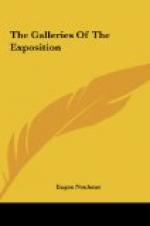Chronological order is not entirely maintained in gallery 58, where two large Bierstadt pictures are in control. Bierstadt, with all of his good painting, does not get any nearer the real spirit of the lofty mountaintops than all the others of this school. Big and earnest as his efforts were, they fall short of real achievement, not so much for his lack of outdoor colour as for the misunderstanding of what is possible in art and what is impossible. Another landscape in this gallery, belonging to the contemporary school, however, is Henry Joseph Breuer’s “Santa Inez Mountains”. It is a faithful study of a most difficult subject and very successful in its big feeling, in spite of the introduction of great detail. It is easily the best Breuer in the collection. The note of variety in this gallery is maintained in several portraits and genre pictures of unusual merit. On the right of the Breuer, Thomas Hicks’ “Friendly Warning” atones for a multitude of mediocre genre pictures in the preceding gallery. Eastman Johnson’s “Drummer Boy” shows good composition, and J. H. E. Partington’s study of a man’s head is as fine a piece of painting as was ever done in the eighties.
Gallery 64.
In a big central gallery we meet the more meritorious work of our painters dependent upon foreign influence. Portraits, genre pictures, landscapes, and marines tell the story of many individual men working out their salvation in more or less original fashion. I have spoken at some length about the pitfall of genre painting, but Thomas Hovenden’s “Breaking Home Ties” redeems the entire school. Irrespective of the fact that it is a picture very popular with the large public by reason of its sentimental appeal, it is well painted, and it will always be considered a good painting. It is devoid of colour, in the sense of the modern painter, but its very fluent and simple technical character recommends it highly. Hovenden was a master of his trade. Anybody who doubts this from his large canvas can easily be convinced by studying the “Peonies” to the left of it on wall C. The large area of this wall is covered with six canvases by Thomas Eakins, showing a variety of subjects. His “Crucifixion” is very good as an academic study but of no other interest. In the “Concert Singer” he added an interesting subject to very admirable painting. His other canvases are all sincerely studied and well done, and they will always be sure of their place in the history of American painting. Opposite the “Crucifixion,” Church’s “Niagara” reminds one that the painting of water involves more than mere photographic facility. All that one can say about this serious effort is that if it had been painted under a different star than that which guided the painters of his time in outdoor studies, it would doubtless look more like water. Another canvas on the right, a marine by Richards, has the same feeling for drawing without showing any understanding of either texture or atmosphere.




